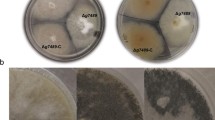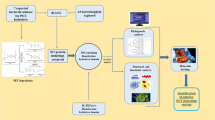Abstract
Multicopper oxidase (MCO) is an enzyme which involves in reducing the oxygen in a four electron reduction to water with concomitant one electron oxidation of reducing the substrate. We have generated the 3-D structure of MCO by homology modeling and validated on the basis of free energy while 90.4 % amino acid residues present in allowed regions of Ramachandran plot. The screening of potential hazardous aromatic compounds for MCO was performed using molecular docking. We obtained Sulfonaphthal, Thymolphthalein, Bromocresol green and Phloretin derivatives of phenol and aromatic hydrocarbon were efficient substrates for MCO. The phylogeny of MCO reveals that other bacteria restrain the homologous gene of MCO may play an important role in biodegradation of aromatic compounds. We have demonstrated the gene regulatory network of MCO with other cellular proteins which play a key role in gene regulation. These findings provide a new insight for oxidization of phenolic and aromatic compounds using biodegradation process for controlling environmental pollution.




Similar content being viewed by others
References
Alcalde M, Bulter T, Arnold FH (2002) Colorimetric assays for biodegradation of polycyclic aromatic hydrocarbons by fungal laccases. J Biomol Screen 7(6):547–553
Altschul SF, Thomas LM, Alejandro AS, Jinghui Z, Zheng Z, Miller W, Lipman DJ (1997) Gapped BLAST and PSI-BLAST: a new generation of protein database search programs. Nucleic Acids Res 25:3389–3402
Bertrand T, Jolivalt C, Briozzo P, Caminade E, Joly N, Madzak C, Mougin C (2002) Crystal structure of a four-copper laccase complexed with an arylamine: insights into substrate recognition and correlation with kinetics. Biochemistry 41(23):7325–7333
Bourbonnais R, Paice MG, Reid ID, Lanthier P, Yaguchi M (1995) Lignin oxidation by laccase isozymes from Trametes versicolor and the role of the mediator 2,29-azinobis (3-ethylbenzthiazoline-6-sulfonate) in kraft lignin depolymerization. Appl Environ Microbiol 61:1876–1880
Buitron G, Gonzalez A, Lopez-Marin LM (1998) Biodegradation of phenolic compounds by an acclimated activated sludge and isolated bacteria. Water Sci Tech 37(4–5):371–378
De Las Rivas J, Montanillo C (2010) Protein-protein interactions essentials: key concepts to building and analyzing interactome networks. PLoS Comput Biol 6:e1000807
De J, Ramaiah N, Mesquita A, Verlekar XN (2003) Tolerance to various toxicants by marine bacteria highly resistant to mercury. Mar Biotechnol 5:185–193
Delano WL (2002) The PYMOL molecular graphics system. Palo Alto CA
Di Patti MC, Pascarella S, Catalucci D, Calabrese L (1999) Homology modeling of the multicopper oxidase Fet3 gives new insights in the mechanism of iron transport in yeast. Protein Eng 12(11):895–897
Freeman JC, Nayar PG, Begley TP, Villafranca JJ (1993) Stoichiometry and spectroscopic identity of copper centers in phenoxazinone synthase—a new addition to the blue copper oxidase family. Biochemistry 32:4826–4830
Haglund C, Levín L, Forchiassin F, López M, Viale A (2002) Degradation of environmental pollutants by Trametes trogii. Rev Argent Microbiol 34(3):157–162
Hirose J, Nasu M, Yokoi H (2003) Reaction of substituted phenols with thermostable laccase bound to Bacillus subtilis spores. Biotechnol Lett 25(19):1609–1612
Huang KX, Fujii I, Ebizuka Y, Gomi K, Sankawa U (1995) Molecular cloning and heterologous expression of the gene encoding dihydrogeodin oxidase, a multicopper blue enzyme from Aspergillus terreus. J Biol Chem 270:21495–21502
Husain Q, Jan U (2000) Detoxification of phenols and aromatic amines from polluted wastewater by using phenol oxidases. J Sci Ind Res 59:286–293
Huston WM, Naylor J, Cianciotto NP, Jennings MP, McEwan AG (2008) Functional analysis of the multi-copper oxidase from Legionella pneumophila. Microbes Infect 10(5):497–503
Laskowski RA, MacArthur MW, Moss DS, Thornton JM (1993) PROCHECK: a program to check the stereochemical quality of protein structure. J Appl Crystallogr 26:283–291
Li Y, Yin J, Qu G, Lv L, Li Y, Yang S, Wang XG (2008) Gene cloning, protein purification, and enzymatic properties of multicopper oxidase, from Klebsiella sp. 601. Can J Microbiol 54(9):725–733
Morris GM, Goodsell DS, Halliday RS, Huey R, Hart WE, Belew RK, Olson AJ (1998) Automated docking using a Lamarckian genetic algorithm and an empirical binding free energy function. J Comp Chem 19:1639–1662
Piontek K, Antorini M, Choinowski T (2002) Crystal structure of a laccase from the fungus Trametes versicolor at 1.90-A resolution containing a full complement of coppers. J Biol Chem 277(40):37663–37669
Potin O, Veignie E, Rafin C (2004) Biodegradation of polycyclic aromatic hydrocarbons (PAHs) by Cladosporium sphaerospermum isolated from an aged PAH contaminated soil. FEMS Microbiol Ecol 51(1):71–78
Sali A, Blundell TL (1993) Comparative protein modeling by satisfaction of spatial restrains. J Mol Biol 234:779–815
Samal A, Jain S (2008) The regulatory network of E. coli metabolism as a Boolean dynamical system exhibits both homeostasis and flexibility of response. BMC Syst Biol 2:21
Schwikowski B, Uetz P, Fields S (2000) A network of protein-protein interactions in yeast. Nat Biotechnol 18(12):1257–1261
Seshadri R, Joseph SW, Chopra AK, Sha J, Shaw J, Graf J, Haft D, Wu M, Ren Q, Rosovitz MJ, Madupu R, Tallon L, Kim M, Jin S, Vuong H, Stine OC, Ali A, Horneman AJ, Heidelberg JF (2006) Genome sequence of Aeromonas hydrophila ATCC 7966T: jack of all trades. J Bacteriol 188(23):8272–8282
Shimizu A, Kwon JH, Sasaki T, Satoh T, Sakurai N, Sakurai T, Yamaguchi S, Samejima T (1999) Myrothecium verrucaria bilirubin oxidase and its mutants for potential copper ligands. Biochemistry 38:3034–3042
Shleev SV, Khan IG, Gazaryan IG, Morozova OV, Yaropolov AI (2003) Novel laccase redox mediators: spectral, electrochemical, and kinetic properties. Appl Biochem Biotechnol 111(3):167–184
Singh V, Somvanshi P (2009a) Homology modeling of adenosine A2A receptor and molecular docking for exploration of appropriate potent antagonists for treatment of Parkinson’s disease. Curr Aging Sci 2(2):127–134
Singh V, Somvanshi P (2009b) Homology modeling of 3-oxoacyl-acyl carrier protein synthase II (KAS II) from Mycobacterium tuberculosis H37Rv and molecular docking for exploration of drugs. J Mol Model 15(5):453–460
Singh V, Somvanshi P (2009c) Inhibition of oligomerization of aerolysin from Aeromonas hydrophila: homology modeling and docking approach for exploration of hemorrhagic septicemia. Lett Drug Des Discov 6(3):215–223
Singh V, Somvanshi P, Rathore G, Kapoor D, Mishra BN (2009) Gene cloning, expression and homology modeling of hemolysin gene from Aeromonas hydrophila. Protein Expr Purif 65:1–7
Singh V, Mani I, Chaudhary DK (2011a) Gene cloning and homology modeling of the 3-oxoacyl-ACP synthase from Aeromonas hydrophila for drug discovery. Lett Drug Des Discov 8(7):619–625
Singh V, Mani I, Chaudhary DK, Somvanshi P (2011b) Molecular detection and cloning of thermostable hemolysin gene from Aeromonas hydrophila. Mol Biol (Mosk) 45(4):551–560
Singh V, Chaudhary DK, Mani I (2012) Gene network analysis of Aeromonas hydrophila for novel drug target discovery. Syst Synth Biol. doi:10.1007/s11693-012-9093-z
Solomon EI, Sundaram UM, Machonkin TE (1996) Multicopper oxidases and oxygenases. Chem Rev 96:2563–2605
Sonoki T, Kajita S, Ikeda S, Uesugi M, Tatsumi K, Katayama Y, Iimura Y (2005) Transgenic tobacco expressing fungal laccase promotes the detoxification of environmental pollutants. Appl Microbiol Biotechnol 67(1):138–142
Suresh PS, Kumar A, Kumar R, Singh VP (2008) An in silico approach to bioremediation: laccase as a case study. J Mol Graph Model 26(5):845–849
Tamura K, Dudley J, Nei M, Kumar S (2007) MEGA4: molecular evolutionary genetics analysis (MEGA) software version 4.0. Mol Biol Evol 24:1596–1599
Thompson JD, Gibson TJ, Plewniak F, Jeanmougin F, Higgins DG (1997) The CLUSTALX windows interface: flexible strategies for multiple sequence alignment aided by quality analysis tools. Nucleic Acids Res 25:4876–4882
Willmott N, Guthrie J, Nelson G (1998) The biotechnology approach to colour removal from textile effluent. J Soc Dyers Colour 114:38–41
Youn HD, Hah YC, Kang SO (1995) Role of laccase in lignin degradation by white-rot fungi. FEMS Microbiol Lett 132:183–188
Acknowledgments
Authors are grateful to A.K. Singh, Satya Prakash and Pritee Singh for providing the suggestions, encouragement and fruitful discussion during preparation of this manuscript. Authors are also grateful to reviewers for their helpful suggestions.
Conflict of interest
There is no competing interest.
Author information
Authors and Affiliations
Corresponding author
Electronic supplementary material
Below is the link to the electronic supplementary material.
Rights and permissions
About this article
Cite this article
Singh, V., Mani, I. & Chaudhary, D.K. Analysis of the multicopper oxidase gene regulatory network of Aeromonas hydrophila . Syst Synth Biol 6, 51–59 (2012). https://doi.org/10.1007/s11693-012-9096-9
Received:
Revised:
Accepted:
Published:
Issue Date:
DOI: https://doi.org/10.1007/s11693-012-9096-9




